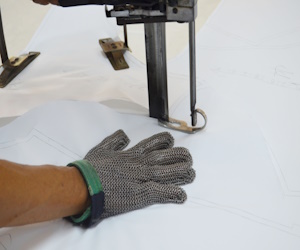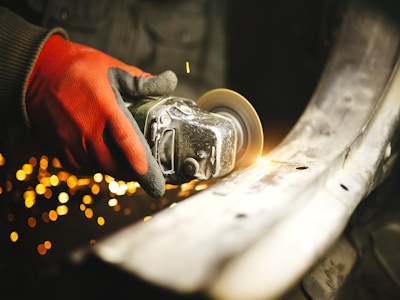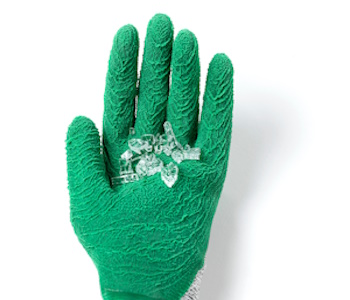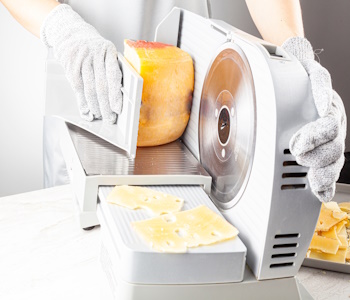All About Cut Protection Gloves

Figure 1: Stainless steel gloves in a clothing factory
Cut protection gloves are designed to protect the hands from cuts and lacerations caused by sharp objects. They are an essential part of personal protective equipment (PPE) and are typically made of strong materials such as Kevlar, stainless steel mesh, or Dyneema. These gloves play a crucial role in enhancing safety in a wide range of industries, from manufacturing and construction to food handling and healthcare. This article discusses the main applications and types of cut protection gloves. Read our industrial PPE overview article for the various types of PPE and their selection criteria.
Table of contents
- Applications
- Cut protection glove materials
- ANSI/ISEA 105-2016 cut standard
- How to choose cut protection gloves
- Limitations
- FAQs
View our online selection of safety goggles and safety hoods!
Applications
Cut-resistant gloves are used across multiple industries:
- Food processing
- Metalworking
- Glassworking
- Construction
- Healthcare
- Law enforcement
- Military
They are also used by people who engage in activities such as hunting, fishing, and woodworking. Cut-resistant gloves are available in various styles and levels of protection (discussed later), that depend on the specific hazards the gloves will protect against. For example, metalworkers and people working in the food processing industry need different types of gloves because of the different hazards they face.It is important to note that no glove is completely cut-proof. However, cut-resistant gloves can significantly reduce the risk of serious injury from cuts and lacerations.

Figure 2: Using cut protection gloves while grinding
Cut protection glove materials
| Material | Features |
| Steel core |
|
| Metal mesh |
|
| Fiber metal blends |
|
| Kevlar aramid fiber |
|
| Spectra fiber |
|
| Dyneema |
|
| Super fabric |
|
Table 1: Cut protection glove materials

Figure 3: High cut resistant gloves for glass
ANSI/ISEA 105-2016 cut standard
The ANSI/ISEA 105-2016 standard categorizes gloves into nine levels of cut protection, with a higher number denoting that the material of the glove needs a greater amount of force to be penetrated by a sharp blade. This scale ranges from 0 to 6,000 grams. The greater the force needed to cut through the materials, the higher the cut resistance rating. A higher rating equates to superior protection and cut performance for the wearer.
| Cut level rating | Weight in grams to cut through the material (20 mm or 0.8 inch of blade travel) | Feature | Application |
| A1 | ≥ 200 | Minimum cut protection | Light duty tasks, such as handling cardboard boxes or paper |
| A2 | ≥ 500 | Minimal hazards and light-cut protection | |
| A3 | ≥ 1000 | Starts to address more medium-level cut hazards but still mostly used for light protection | |
| A4 | ≥ 1500 | Addresses medium-level cut hazards, with level 5 approaching heavy-duty |
Medium-duty tasks, such as handling sharp knives or metal |
| A5 | ≥ 2200 | ||
| A6 | ≥ 3000 | Starts to address more heavy-cut hazards | |
| A7 | ≥ 4000 | Used for heavy-cut hazards | |
| A8 | ≥ 5000 | Used in dangerous environments that involve cut hazards | Heavy-duty tasks, such as working with chainsaws or glass |
| A9 | ≥ 6000 | Used in extreme cut hazards |
Table 2: ANSI/ISEA 105 (2016) cut levels
How to choose cut protection gloves
To choose the right protection gloves for cutting, follow these steps:
- Identify hazards: Understand the specific cutting hazards faced by the workers.
- Determine cut resistance level: Use the cut resistance level (Table 2) as a guide to select the appropriate one based on the hazards.
- Select the material: Choose the material that best suits the needs, whether it's cut-resistant fibers, metal mesh, or a combination of materials.
- Assess comfort and fit: Ensure the gloves are comfortable and provide a snug fit for optimal dexterity.
- Consider additional features: Additional features like impact resistance or grip enhancements may be needed depending on the workplace.
- Test and train: Test the gloves to ensure they meet your expectations and provide proper training to workers on their correct usage.
Example
In a commercial kitchen, workers regularly handle sharp knives and slicers. risk of accidental knife cuts while chopping vegetables, slicing meat, or fileting fish. There's also the potential for injuries when using mandolines and other kitchen equipment with sharp blades. In this case, the workers need protective cutting gloves with high cut resistance, typically made of materials like Kevlar or Dyneema, with a cut level of A4 or higher to protect against sharp knife blades and slicers. Additionally, they should select gloves that provide a good grip to prevent accidents while using kitchen tools and equipment.

Figure 4: Cut resistant gloves used in the food processing industry
Limitations
Limited puncture protection: Cut protection gloves are primarily designed to resist sharp-edged objects and cuts. They may not provide effective protection against punctures from pointed objects or needles.
Limited chemical resistance: Most cut protection gloves are not designed to provide protection against chemical exposure. If you work with hazardous chemicals, it's crucial to use gloves specifically rated for chemical resistance to prevent skin contact with harmful substances.
Reduced dexterity: While cut protection gloves offer varying levels of dexterity, they can still limit fine motor skills and tactile sensitivity compared to not wearing gloves at all. In tasks that require precise hand movements, workers may need to balance protection with dexterity.
FAQs
What are cut protection gloves?
Cut protection gloves are gloves that are designed to protect the hands from cuts and lacerations caused by sharp objects.
Are cut resistant gloves cut proof?
Cut resistant gloves are not completely cut proof, but they can significantly reduce the risk of serious injury from cuts and lacerations.
What materials are used to make gloves that protect from cuts?
Cut protection gloves are made from strong, durable materials such as Kevlar, Dyneema, or stainless steel mesh.
Are cut resistant gloves washable?
Most cut resistant gloves are washable, but it is important to check the care instructions before washing them.















